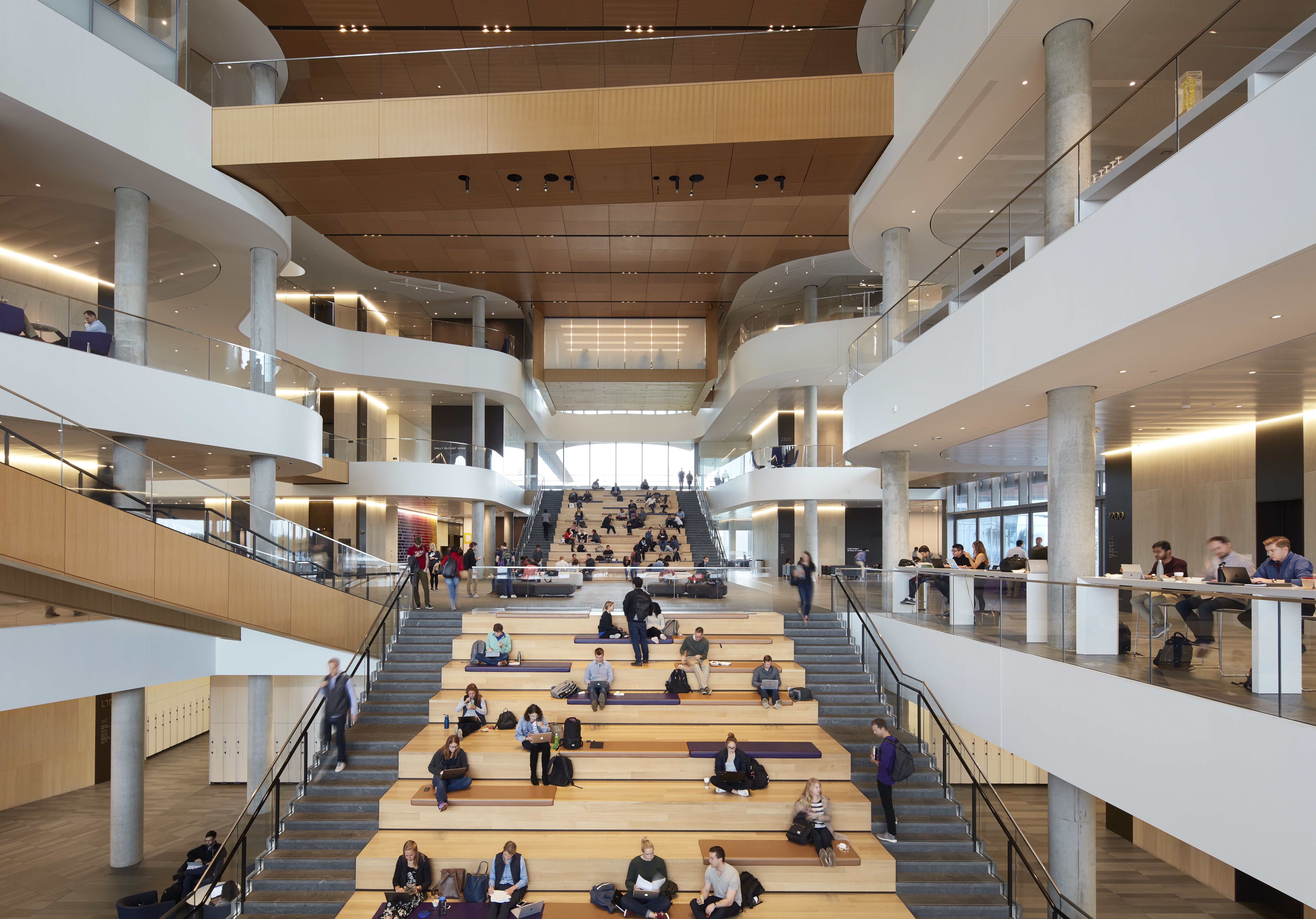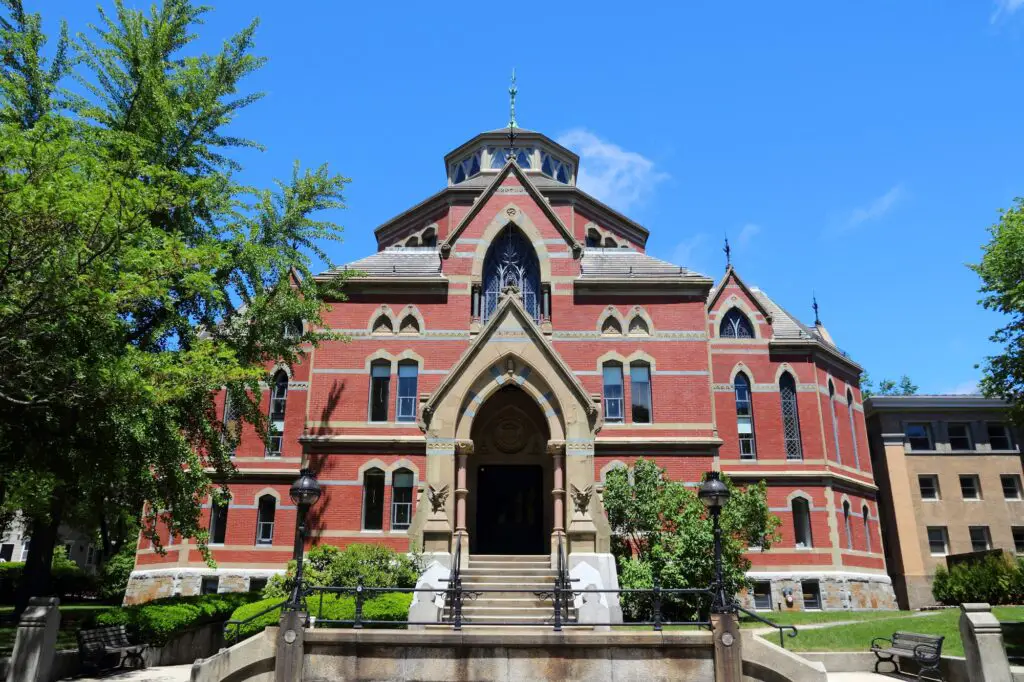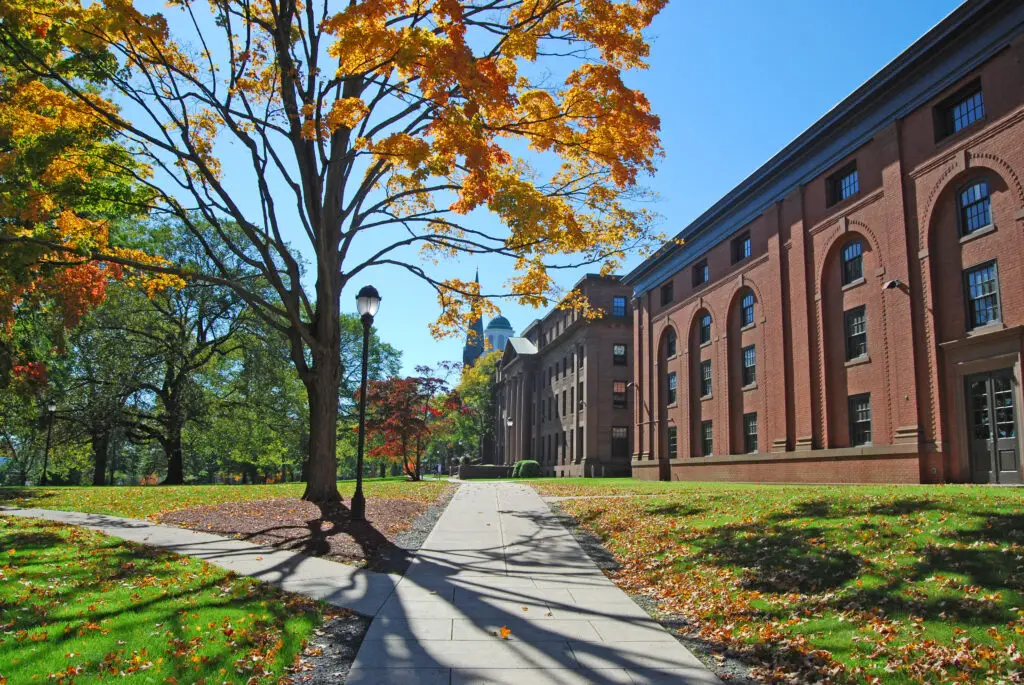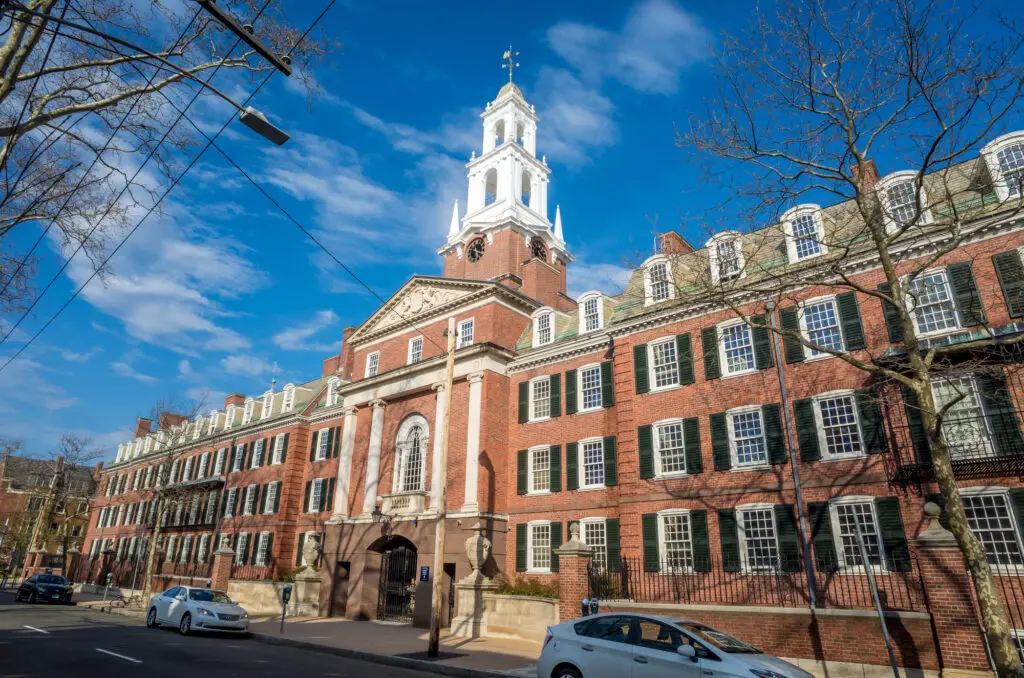Now, what makes expensive colleges in the US cost as much as luxury cars? More than academics, these schools offer exclusive resources and unmatched connections — a package that can (possibly) justify the hefty price tag.
But is it worth it? This article will break down the costs and help you decide if the exclusive experience on offer aligns with your academic and financial goals. Let’s crack open the vault and explore the 10 most expensive colleges in the country.
Heads up: The sticker prices listed here are before financial aid is considered, which can include scholarships, grants, work-study programs, and loans.
How Much Do the Most Expensive Colleges Cost?
The ever-increasing price tag of a college education is a major hurdle for many students navigating the path to higher learning. Over the years, the cost of attending colleges and universities has risen significantly. As of the 2023-2024 academic year, the average published tuition and fees for full-time undergraduate students are as follows:
- Public four-year in-state: $11,260
- Public four-year out-of-state: $29,150
- Public two-year in-district: $3,990
- Private nonprofit four-year: $41,540
Good to know: Private universities are often more expensive than public ones due to smaller class sizes, better facilities, and more extensive research programs. They rely more on tuition and donations because they receive less government funding.
1. University of Chicago
With a selective acceptance rate of approximately five percent, UChicago offers a personalized educational experience characterized by intimate class sizes. This exclusivity not only enhances individual attention and learning but also allows the university to charge premium rates.
The school has top-notch faculty, rigorous academic programs, and a wealth of extracurricular activities and student organizations, meaning that the high sticker prices at UChicago do little to deter scholars from diverse backgrounds. Groups like the South Asian Students Association, which celebrates South Asian heritage with cultural shows and music nights, and Queers & Associates, which provides a supportive space for LGBTQ+ students and hosts a range of events, foster a welcoming and inclusive environment for all.
The college also has a rich tradition of contributing to groundbreaking research across various disciplines, hosting more than 160 research centers and institutes, including the Pritzker School of Molecular Engineering and the Institute of Politics. 🔬
Good to know: Despite being one of the most expensive colleges, UChicago’s Empower Initiative offers to cover full tuition for students from families earning under $125,000 per year, with comprehensive aid (including room and board) for those making under $60,000.
💰 Cost of attendance: $93,633 (on-campus) and $91,026 (off-campus)
📍 Location: Chicago, Illinois
📈 Acceptance rate: 5 percent
🏫 Type: Private
2. Northwestern University

Northwestern University (NWU) is known for its beautiful campus, equipped with state-of-the-art facilities like libraries, research centers, a recreation complex, and performance venues. This college even has an exemplary healthcare system, recognized for its comprehensive services and support dedicated to student well-being. 📚
One factor contributing to NWU’s high cost is its reliance on tuition revenue. Unlike many public universities that receive significant state funding, NWU must cover its operating costs primarily through student tuition fees. Furthermore, Evanston, Illinois, where the university is located, boasts a relatively high cost of living of approximately $2,199 per month, which places it in the top 14 percent of the most expensive cities globally.
However, this tuition translates into academic excellence. NWU offers strong programs across various disciplines, particularly excelling in areas like journalism, business, engineering, and performing arts. 🗞️
💰 Cost of attendance: $94,878 (on-campus and off-campus)
📍 Location: Evanston, Illinois
📈 Acceptance rate: 7 percent
🏫 Type: Private
3. University of Pennsylvania
Penn’s reputation transcends its Ivy League affiliation. It’s a powerhouse of innovation, exemplified by its creation of the Electronic Numerical Integrator and Computer (ENIAC), the first general-purpose electronic computer.
Situated among the academic giants, Penn offers rigorous programs and draws top professors who are pioneers in their research fields. The pursuit of excellence, however, requires substantial resources. Penn’s world-class facilities, extensive libraries, and advanced labs are supported by a hefty $20.7 billion endowment, placing it among the wealthiest private universities in the US.
This investment in infrastructure is matched by its commitment to research, with expenditures ranking fourth nationally, underscoring its dedication to expanding the frontiers of knowledge.
The location also affects Penn’s overall cost. Nestled in Philadelphia, Penn offers the charm of a traditional campus alongside the vibrancy of a major city. This unique blend provides cultural experiences, internship opportunities, and a dynamic atmosphere, but maintaining a large campus in a prime urban location is expensive.
💰 Cost of attendance: $92,288 (on-campus) and $91,474 (off-campus)
📍 Location: Philadelphia, Pennsylvania
📈 Acceptance rate: 7 percent
🏫 Type: Private
4. Columbia University
Columbia University — the name evokes images of academic excellence, a bustling New York City lifestyle, and a prestigious alumni network that includes country presidents, CEOs, and Nobel laureates. The rich history and influential graduate pool contribute to Columbia’s prestige and the value associated with a Columbia degree.
However, there is a price for this distinction. Columbia’s prime location in New York City comes with a high cost of living. But this same location allows Columbia to leverage world-class museums, theaters, industry events, and networking opportunities, offering students unparalleled experiences beyond the classroom.
In return, Columbia ensures that you receive your money’s worth through top-notch amenities, such as the Dodge Fitness Center and Lerner Hall. It continuously updates its world-class facilities during breaks, remodels structures, and upgrades resources to provide a modern and comfortable instructional environment.
💰 Cost of attendance: $89,587 on-campus
📍 Location: New York, New York
📈 Acceptance rate: 4 percent
🏫 Type: Private
5. Brown University

Brown University is among the most expensive colleges in the US. Its pricey tuition supports a low student-faculty ratio, allowing more personalized attention and in-depth learning experiences. It also constantly upgrades its facilities, including cutting-edge research labs, historic libraries, and dorms, year after year to ensure a modern and stimulating environment for students.
In addition, Brown’s strong alumni network and reputation for academic excellence open doors to prestigious graduate programs and promising careers, so investing in a degree is worthwhile for many students.
Students are drawn to Brown’s unique Open Curriculum, which allows them to explore a wide range of subjects, like ancient Egyptian hieroglyphics, the chemistry of brewing beer, or the philosophy of artificial intelligence, before committing to a major. This flexibility fosters intellectual curiosity and interdisciplinary learning.
💰 Cost of attendance: $91,676 (on-campus and off-campus)
📍 Location: Providence, Rhode Island
📈 Acceptance rate: 5 percent
🏫 Type: Private
6. Wesleyan University

For students seeking a top-tier liberal arts education that extends far beyond textbooks, Wesleyan’s higher cost of attendance can be seen as an investment in their future.
Wesleyan is proud of its exceptional facilities. For example, the Science Center boasts a nuclear magnetic resonance machine, a powerful tool for scientific research not found at many undergraduate institutions. Additionally, the Allbritton Center houses state-of-the-art multimedia studios and collaborative spaces, facilitating cutting-edge research and creative projects in social sciences and humanities.
The university also boasts a well-stocked library with extensive archives and a vibrant arts scene, with studios, theaters, and performance spaces that provide students with exceptional creative outlets.
💰 Cost of attendance: $92,994 (on-campus and off-campus)
📍 Location: Middletown, Connecticut
📈 Acceptance rate: 17.1 percent
🏫 Type: Private
7. Harvey Mudd College
A Harvey Mudd degree holds significant weight. Despite its reputation for being one of the most expensive colleges in the country, it continues to attract top talent in the fields of science, technology, engineering, and mathematics (STEM).
The college fosters an immersive learning experience that prioritizes collaboration, with small class sizes and personalized instruction. Here, you’ll be guided by Ph.D.-holding professors with a passion for undergraduate education.
This college’s facilities and programs are also showstoppers. For example, the Keck Science Center‘s NMR spectrometers and laser labs let students conduct cutting-edge research, while the Entrepreneurship Network equips graduates with practical skills and industry connections.
💰 Cost of attendance: $93,131 (on-campus and off-campus)
📍 Location: Claremont, California
📈 Acceptance rate: 13 percent
🏫 Type: Private
8. Yale University

Yale’s longstanding history, academic prestige, and influential alumni make it highly desirable to students and faculty despite being one of the most expensive colleges in the US. The Ivy League opens doors to lucrative careers internationally in business, law, medicine, arts, and academia, and its extensive alumni network supports current students through mentorship and job placements.
Nurturing students’ holistic development is a priority at Yale, so extensive support services, from academic advising to career counseling, beef up the price tag of its premium education.
Additionally, Yale’s academic prowess is fueled by its esteemed faculty — top scholars from diverse fields who engage in groundbreaking research alongside aspiring students.
💰 Cost of attendance: $90,975 on-campus
📍 Location: New Haven, Connecticut
📈 Acceptance rate: 5 percent
🏫 Type: Private
9. Tufts University
Tufts University is a top research university. The Carnegie Foundation awarded it the highest ranking for its significant research contributions in many different subjects.
Tufts researchers have made significant strides in combating chronic diseases by developing novel therapeutic strategies that enhance patient outcomes. The university has also contributed to advances in material science and biomedical engineering, leading to improvements in everyday technologies and healthcare solutions.
However, tuition shouldn’t be the sole deterrent. Unlike some universities with larger endowments, Tufts relies more on student tuition to cover operational costs. Additionally, its location near Boston contributes to the overall cost of attendance due to the high cost of living in the area, impacting housing, transportation, and dining.
💰 Cost of attendance: $84,600 on-campus and off-campus
📍 Location: Medford, Massachusetts
📈 Acceptance rate: 10.1 percent
🏫 Type: Private
10. University of Southern California
A hub for the entertainment industry, Los Angeles transforms USC into a gateway for unparalleled opportunities. Students gain direct access to internships, research, and professional connections across various media sectors, especially in film, music, and media.
Being a selective university with a low acceptance rate, USC commands a premium tuition. In turn, USC equips its students for success with innovative research facilities, modern classrooms, and world-class libraries.
Whether you’re honing your craft at the Annenberg School for Communication and Journalism or conducting groundbreaking research at the Viterbi School of Engineering, USC provides the tools and resources to excel in your chosen field.
💰 Cost of attendance: $95,225 on-campus and off-campus
📍 Location: Los Angeles, California
📈 Acceptance rate: 12 percent
🏫 Type: Private
Highlighting these 10 most expensive colleges has hopefully shed light on the luxurious (and sometimes staggering) cost of higher education. But your dream education doesn’t have to break the bank. Explore your options, prioritize value, and find the college that unlocks your full potential, no matter the price tag. 💲
Most Expensive Colleges in the US: Frequently Asked Questions
What are the most expensive colleges in the US?
Several schools with sticker prices hovering around or exceeding $74,000 annually topped the list. These include Harvey Mudd College and Claremont McKenna College in California, St. Lawrence University in New York, and Carnegie Mellon University in Pennsylvania.
What’s the difference between sticker price and net price?
While a college’s advertised “sticker price” reflects the full cost of tuition, fees, room, and board, it often misrepresents what most students pay.
Universities offer a variety of financial aid packages, including grants, scholarships, and work-study programs, which can significantly reduce the actual cost of attendance for many students.
The net price is the actual cost that a student pays after accounting for financial aid, scholarships, and grants. It considers discounts and support that minimize the student’s overall expenses. In essence, the net price is the amount you will have to pay out of pocket after accounting for all financial aid.
How can I afford to attend an expensive college?
Students can look into scholarships, grants, and financial aid packages offered by the college and other organizations to afford an expensive school.
Participating in work-study programs, taking up part-time employment, and budgeting properly can all assist with expenses.
What is the least expensive college in the US?
Pinpointing the absolute least expensive college in the US is tricky because costs can vary depending on residency status and financial aid. However, there are budget-friendly options for colleges across the country that are known for their affordability, like South Georgia State College, the College of Central Florida, Daytona State College, State College of Florida – Manatee–Sarasota, and Saint Johns River State College.


